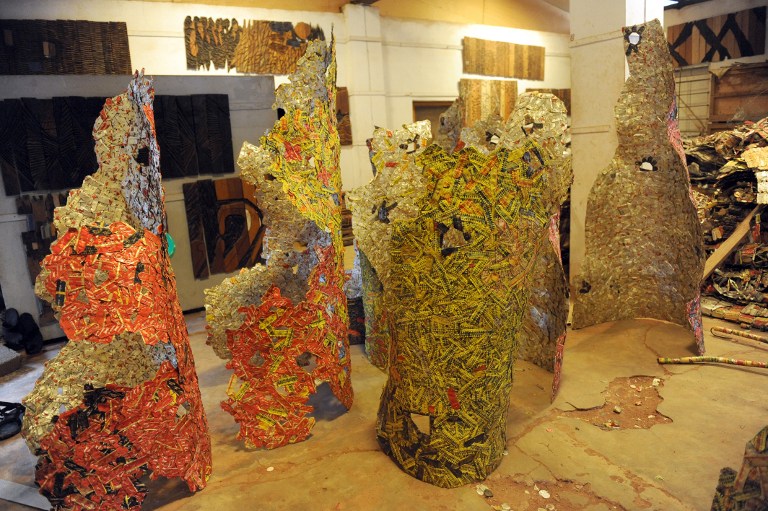
LAGOS — Giles Peppiatt, from Bonhams in London, had good reason to make the trip to Nigeria’s financial capital, Lagos, for the auction house’s next sale of African art — a glut of potential buyers.
On a recent visit, he described Africa as “one of our hottest properties on the art block.”
“In some ways, Africa is the new China when it comes to art,” he added. “We are investing time, money and people to maintain our presence in this market.”
Bonhams has blazed a trail in the sector, having organized its first “Africa Now” sale of modern and contemporary African art in 2007, which has since become an annual event.
Among its most expensive sales was “Arab Priest” (1945) by South African painter Irma Stern, which was bought by the Qatar Museums Authority for just over three million pounds (4.2 million euros, $4.7 million) in 2011.
“New World Map” (2009) — one of Ghanaian artist El Anatsui’s tapestries embroidered from crushed aluminum bottle tops and copper wire — went for nearly 550,000 pounds the following year.
A series of seven wooden sculptures by Nigeria’s Ben Enwonwu fetched 361.250 pounds — triple the estimate price.
Increasing interest
Leading African artists were virtually absent from art sales just a decade ago but now contemporary works feature strongly in sales at several international auction houses.
Another El Anatsui tapestry sold for $1.4 million at Sotheby’s.
“When institutions such as the Tate (in London) and the Smithsonian (in Washington DC) start to acquire contemporary African art, one then knows something wonderful has occurred,” said Peppiatt.
On the back of successful sales in recent years, Bonhams is specializing even more this year, with a selection of modern art going under the hammer this month and contemporary art in October.
In Africa, the Zinsou foundation’s museum of contemporary African art in Ouidah, Benin, and and the forthcoming opening of the huge Zeitz Museum of Contemporary Art in Cape Town, South Africa, are clear signs of the increasing interest of collectors.
Most of the buyers at Bonhams’ “Africa Now” sales are African, explained Peppiatt.
“A lot of collectors are very wealthy Nigerian businessmen,” he added.
Culture and heritage
“Nigerian art collectors want a piece of their own culture and heritage and are prepared to invest in that,” added Bonhams’ representative in Lagos, Neil Coventry.
“What’s fascinating is that these pieces are being found all over the world. In some cases they are coming back to Nigeria where they are valued and appreciated the most.”
Coventry, whose living room walls at his house overlooking the Lagos lagoon are covered with major Nigerian works of art, cites the example of Enwonwu.
The painter and sculptor, who died in 1994, was once as famous a name in Nigeria as Britain, where he was notably the first black African artist commissioned to make a sculpture of Queen Elizabeth II in 1957.
But his name was forgotten and only rediscovered in recent years.
“He was an international artist and Africa’s premier modern artist,” said Coventry.
“Collectors who bought pieces by Enwonwu early in his career are now getting older and those who have inherited works may have no idea of the value of what they have.
“This rediscovery of Ben Enwonwu’s works is amazing.”
Positive image
Ten years ago, Enwonwu’s works sold for several hundred dollars but are now fetching hundreds of thousands at auction.
Nevertheless, said Coventry, his work “is still massively under-valued, which is quite unique for an artist who was so accomplished during his own lifetime”.
Femi Lijadu is one of several art collectors who will make the trip from Lagos to London for the auction on May 20 and has already pinpointed Nigerian works “at affordable prices.”
He will be in the British capital because he is proud of the image the major artists portray of his country.
Lijadu, a corporate lawyer, has some 500 pieces in his collection and remembers the time he began earning a living in the 1980s and buying pictures by the “Grand Masters” of Nigeria.
“At the time we dreamt of the day where the world would finally start to take notice of Nigerian and African art in general,” he remembered with a smile.
Judging by the scale of the auction, that day has arrived.

